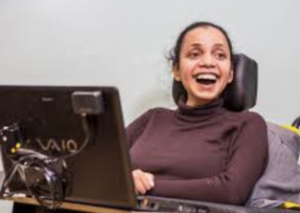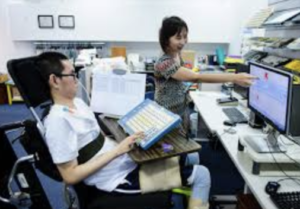Disability: Is technology changing the game?
This may come as a surprise, but disability rates have been rising for the past twenty years. There are many reasons for this, including wars and, in developed countries, an aging population and an increase in the number of people with chronic conditions. According to the World Health Organization (WHO), more than one billion people live with some form of disability.
These figures provide a measure of the usefulness of technical aids. However, it is questionable whether the development of compensation techniques can help to change the place of disabled people in our societies.
The central issue of integration
 Borrowed from the English “hand in cap,” the term comes from equestrian sports. It originally refers to the application of a disadvantage on the best competitors (e.g., extra weight on the best horses), to equalize their chances with the worst, during “handicap races.”
Borrowed from the English “hand in cap,” the term comes from equestrian sports. It originally refers to the application of a disadvantage on the best competitors (e.g., extra weight on the best horses), to equalize their chances with the worst, during “handicap races.”
The emergence of the word “disability” constitutes a significant break when it comes to the consideration of persons with disabilities. After centuries of emphasizing otherness and disability, of excluding individuals from the social norm, the word signals a disadvantage that the collective considers morally necessary to include everyone in the social competition. Thus, far from the “infirm,” the “handicapped” is immediately part of a strong desire to include members considered to be the weakest.
The scope of disability is much wider. WHO defines it as “the result of the interaction between an alteration, lasting or definitive, of one or more motor, sensory or intellectual functions and the obstacles encountered in the material and social environment.” In most developed countries, recent legislation bears the mark of this vision, working on equal rights and opportunities, participation in collective life: access to work, to transport, to public spaces, but also to elective functions.
Overall, disability care can nowadays be defined as a set of measures (legislative, educational, technical) designed to compensate for it. It is in this context that the contributions of technological innovation, which raise great hopes, should be assessed. Where is the fastest progress being made?
The senses: prostheses and software
Many agree on this point, the greatest progress being made concerns the two main sensory handicaps: deafness and blindness.
Concerning deafness, the last prostheses make it possible to limit the noise pollution of background noises and thus facilitate the conversations.
Beyond technology
 Reducing possible sources of disability remains a priori very useful. It is the meaning, for example, of prevention against rubella, responsible for fetal malformations, road prevention, or a more general fight against the state of misery responsible of severe deficiencies (nutritional deficiencies, mental retardation…). Moreover, technology, however advanced it may be, can do nothing against the social environment, which considerably varies the way one lives with a disability (family conditions, quality of housing, socio-economic level, legislation and the mentality of the country…). Moreover, the diffusion of these new technologies is indeed hampered by its prohibitive prices, due to the lack of a market large enough to make the costs profitable.
Reducing possible sources of disability remains a priori very useful. It is the meaning, for example, of prevention against rubella, responsible for fetal malformations, road prevention, or a more general fight against the state of misery responsible of severe deficiencies (nutritional deficiencies, mental retardation…). Moreover, technology, however advanced it may be, can do nothing against the social environment, which considerably varies the way one lives with a disability (family conditions, quality of housing, socio-economic level, legislation and the mentality of the country…). Moreover, the diffusion of these new technologies is indeed hampered by its prohibitive prices, due to the lack of a market large enough to make the costs profitable.
Disability as a source of innovation?
Contact lenses to control your blood sugar. Sounds crazy? No it is not.
Simplifying diabetes monitoring? This is the objective of the pharmaceutical group Novartis, in partnership with the giant Google. Starting from the principle that the modification of the glucose level in the blood is perceptible, with a delay of a few minutes, in the tears, they developed a prototype of lenses having a glucose sensor and a wireless antenna, in order to be able to transmit the information to a connected device, of type tablet or Smartphone. Read this comparatif lentilles contact to find more!
Considered technologically feasible, this innovation, which is still in its early stages of development, could become a less restrictive alternative to blood glucose meters based on a patient’s blood sample.